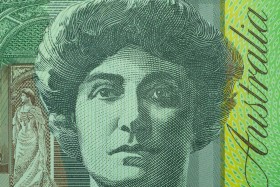
The Australian dollar fell today amid the worsening market sentiment. The traders’ mood soured after tensions between the United States and China escalated over the protests in Hong Kong, while US President Trump signaled that he is going to push for higher tariffs on Chinese goods if a trade deal between the world’s two biggest economies will not be reached. The Aussie rallied yesterday despite the dovish monetary policy meeting minutes released by the Reserve Bank of Australia.
Yesterday, the RBA released minutes of its monetary policy meeting that has happened on November 5. Market analysts noted a clear dovish bias of the central bank. While policymakers kept interest rates unchanged at the gathering, the minutes said that “members reviewed the case for a further reduction at the present meeting”. But the potential negative effects of monetary easing outweighed the possible positive impact, at least for the time being:
While members judged that lower interest rates were supporting the economy through the usual transmission channels (including a lower exchange rate, higher asset prices and higher cash flows for borrowers), they recognised the negative effects of lower interest rates on savers and confidence. They also discussed the possibility that a further reduction in interest rates could have a different effect on confidence than in the past, when interest rates were at higher levels.
Yet members of the Reserve Bank Board also hinted that the rates will remain low for a prolonged time and a reduction can still happen if need be:
As part of their deliberations, members also agreed that it was reasonable to expect that an extended period of low interest rates would be required in Australia to reach full employment and achieve the inflation target. The Board would continue to monitor developments, including in the labour market, and was prepared to ease monetary policy further if needed to support sustainable growth in the economy, full employment and the achievement of the inflation target over time.
The WestpacâMelbourne Institute Leading Index released today showed a small increase in the six month annualized growth rate from â1.01% in September to â0.91% in October. Westpac Chief Economist Bill Evans commented on the result:
Despite a slight improvement in the month, the Leading Index growth rate remains materially below trend and continues to point to weak economic momentum carrying well into 2020.
As for the monetary policy outlook, he said:
The Reserve Bank Board next meets on December 3. Westpac expects the Board to hold the cash rate steady at that meeting. The minutes of the November Board meeting signalled that the Board continues to hold a clear easing bias while, for now, remaining in âmonitor modeâ. We expect that by next February the Board will have received enough information on the impact of the three cuts we have seen since June to acknowledge the need to reduce the cash rate by a further 0.25%, maintain a clear easing bias and consider introducing unconventional policies
AUD/USD dropped from 0.6826 to 0.6810 as of 11:47 GMT today. EUR/AUD advanced from 1.6222 to 1.6236, touching the high of 1.6262 intraday. AUD/JPY fell from 74.09 to 73.85.
If you have any questions, comments, or opinions regarding the Australian Dollar, feel free to post them using the commentary form below.